
The Ardchattan Priory was a Valliscaulian monastic community in Ardchattan, Argyll, Scotland.

The Ardchattan Priory was a Valliscaulian monastic community in Ardchattan, Argyll, Scotland.
The Priory was founded in 1230 by Duncan MacDougal, Lord of Argyll. [1] The most widely believed origin of Clan Chattan is that Clan MacDougal appointed Gillichattan Mor as the Ballie or protector of the Priory lands on their behalf. [2]
In 1308, Robert the Bruce's campaign in the area included holding a council of local chiefs at the Priory, which is believed to have been the last Gaelic-speaking parliament in Scotland. [3]
From the early 14th century, the Prior of Ardchattan held the chantership of Lismore Cathedral. [ clarification needed ]
In April 1510 the Priory was incorporated as a cell of Beauly Priory and may have become Cistercian, but the evidence is slight. It was annexed to the bishopric of the Isles in 1615.
The Priory passed into the hands of Clan Campbell in the 16th century who converted the south range of the conventual buildings into a private dwelling house, and the choir and transepts of the church were used for parochial worship. The monastic church fell into disuse, except for the purpose of burial, following the erection of a new parish church in 1731–2. [4]
The surviving elements of the Priory buildings comprise remains of the original 13th-century church, such as the south transept and its chapels plus traces of 15th and early 16th century additions such as the choir, burial aisles and a sacristy. The remains also shelter a number of carved stones. The Priory structure, the burial ground and the carved stones have been collectively designated a scheduled ancient monument by Historic Environment Scotland. [5]
According to the Ardchattan Priory Gardens website, "a garden has existed at Ardchattan for over 700 years, since Valliscaulian monks, from a little known order in Burgundy, first settled here, on the north shore of Loch Etive. Facing south, with spectacular views over Loch Etive, one can look east to Ben Cruachan and west to the hills of Mull, the monks chose their site well." [6]
There are a number of roses in the priory gardens, herbaceous borders, and over thirty varieties of trees. "On entering the garden, shrub walks lead off the main drive. The neutral soil and temperate climate allow a wide variety of plants to thrive: a huge Cornus kousa, Eucryphia glutinosa, Hoheria lyalii mingle with scented roses and philadelphus. A wild flower meadow planted under a variety of sorbus trees is a more recent addition. Extensive lawns are bordered by herbaceous beds, roses and a rockery." [7]
The gardens are also listed by Historic Environment Scotland because of their high historical, horticultural and scenic value. [8]
"Ardchattan Priory whose yew trees (Taxus baccata), according to other accounts, were inspected by Robert the Bruce and cut to make at least some of the longbows used at the Battle of Bannockburn." [9]
Lismore is an island of some 2,351 hectares in the Inner Hebrides of Scotland. The climate is damp and mild, with over 166 centimetres (65 in) of rain recorded annually. This fertile, low-lying island was once a major centre of Celtic Christianity, with a 6th-century monastery associated with Saint Moluag, and later became the seat of the medieval Bishop of Argyll. There are numerous ruined structures, including a broch and two 13th-century castles.

Argyll, sometimes called Argyllshire, is a historic county and registration county of western Scotland.

Loch Etive is a 30 km sea loch in Argyll and Bute, Scotland. It reaches the sea at Connel, 5 km north of Oban. It measures 31.6 km long and from 1.2 km to 1.6 km (1 mi) wide. Its depth varies greatly, up to a maximum of 150 m (490 ft).
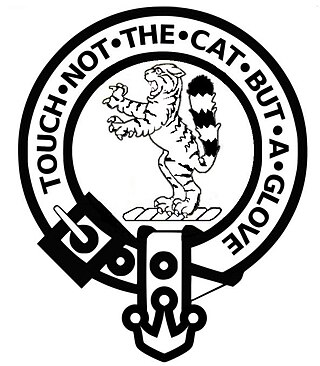
Clan Chattan is a unique confederation of Highland clans. The clan is distinctive in highland clan history in that it was acknowledged to be a community or confederation, of twelve separate Scottish clans, who each had their own clan chief recognized under Scottish law, but who were united under and bound to a superior chief of the confederation for mutual solidarity, sustenance and protection in the Middle Ages and early modern period in the Scottish Highlands.
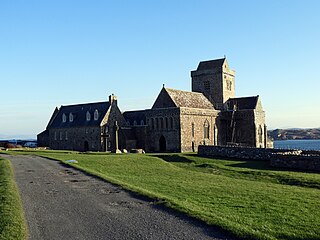
Iona Abbey is an abbey located on the island of Iona, just off the Isle of Mull on the West Coast of Scotland.

Dunstaffnage Castle is a partially ruined castle in Argyll and Bute, western Scotland. It lies 3 miles (5 km) NNE of Oban, situated on a platform of conglomerate rock on a promontory at the south-west of the entrance to Loch Etive, and is surrounded on three sides by the sea. The castle and the nearby chapel ruin have been a Historic Scotland property since 1958. Both are Scheduled Ancient Monuments.
Ardchattan and Muckairn is a civil parish within Argyll and Bute in Scotland. It lies north of Oban, bordering Loch Etive and includes Glen Ure, Glen Creran, Barcaldine, Benderloch, Connel, Bonawe and Glen Etive. At the 2001 census, Ardchattan and Muckairn had a population of 2,443, between them. Its name derives from the 6th-century Irish monk Saint Cathan, combined with the Goidelic element ard-, or "heights".
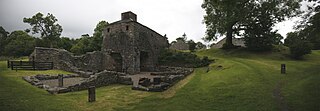
Bonawe is a village in Ardchattan Parish Argyll and Bute, Scotland opposite Taynuilt on the north shore of Loch Etive, most famous for the shipping firm J & A Gardener's Bonawe Quarry - now owned by Breedon Aggregates Scotland Ltd. Bonawe is primarily a linear settlement along on the B845 road and the coast. The iron furnace is at Bonawe in Glenorchy & Inishail Parish across Loch Etive nr Taynuilt in Muckairn Parish.

Saddell Abbey is a ruined Cistercian monastery located in western Scotland. The abbey was established in 1160 by Somerled, Lord of Kintyre, who was killed in 1164. The abbey was completed by his son, Ragnall, a few years later. The original layout of the abbey included a church and three adjoining buildings grouped around a cloister. Saddell Abbey is widely known for its important collection of life-sized stone carvings and burial slabs that were constructed from the 14th to the 16th centuries. Historic Environment Scotland established the site as a scheduled monument in 1975.
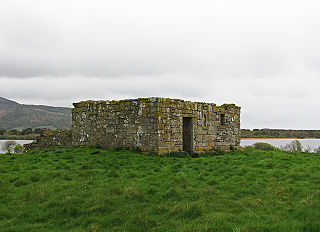
The St Serf's Inch Priory was a community of Augustinian canons based, initially at least, on St Serf's Inch in Loch Leven, Perth and Kinross, Scotland.

Beauly Priory was a Valliscaulian monastic community located at "Insula de Achenbady", now Beauly, Inverness-shire. It was probably founded in 1230. It is not known for certain who the founder was, different sources giving Alexander II of Scotland, John Byset, and both. The French monks, along with Bisset, had a strong enough French-speaking presence to give the location and the river the name "beau lieu" and have it pass into English.
The Prior of Ardchattan was the head of the Valliscaulian, and then Cistercian, monastic community of Ardchattan Priory, Argyll. It was founded in 1230 by Duncan MacDougal, Lord of Argyll. In April 1510 it was incorporated as a cell of Beauly Priory. It was annexed to the bishopric of the Isles in 1615. The following are a list of abbots and commendators:
Donnchadh of Argyll or Donnchadh mac Dubhghaill was a late 12th and early 13th century Scottish noble. He was the son of Dubhghall mac Somhairle, son of Somhairle mac Gille Bhrighde. He is the first of the MacDougall lords of Argyll to take the title de Argadia, and can be regarded as the founder of the successful MacDougall lordship of Argyll. He was also a prominent builder, notable for his construction of Ardchattan Priory and Dunstaffnage Castle.

Finlaggan is a historic site on Eilean Mòr in Loch Finlaggan. The Loch, the island, and Finlaggan Castle lie on Islay, around two kilometres to the northwest of Ballygrant.
Saint Cathan, also known as Catan, Cattan, etc., was a 6th-century Irish monk revered as a saint in parts of the Scottish Hebrides.

Glenorchy Parish Church is a congregation of the Church of Scotland in the village of Dalmally, Argyll and Bute, Scotland. It is the parish church of the parish of Glenorchy and Inishail. The church is also known as Glenorchy Kirk, and was historically known as the Church of Dysart. There have been many alternate spellings, including "Dysert", "Disart", "Glenwrquha", "Glenvrquha", "Glenvrquhay", "Clachandysert", "Clachan Disert, "Claghan-Diseirt" and "Dysart and Glenurquhie".

Tor Castle is a ruined castle, about 3 miles north east of Fort William, Highland, Scotland, west of the River Lochy and east of the Caledonian Canal, near Torlundy.
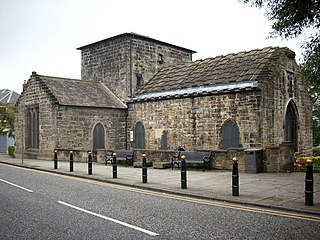
The Priory Church of St Mary of Mount Carmel, commonly called the Priory Church or St Mary's Episcopal Church, is a congregation of the Scottish Episcopal Church located in South Queensferry, near Edinburgh, Scotland.

Clan MacPhail or the Sons of Paul is a Scottish clan of the Scottish Highlands. Known in Scottish Gaelic as Conchie Dhu or Condochy Doye, the clan is mainly associated with the confederation of Clan Chattan.